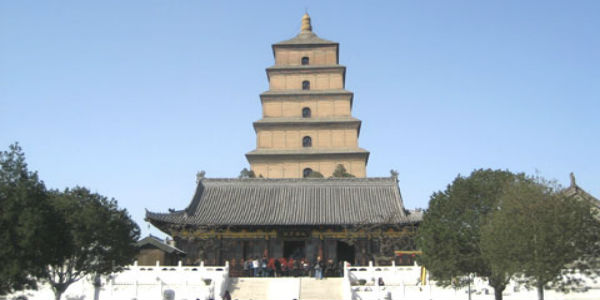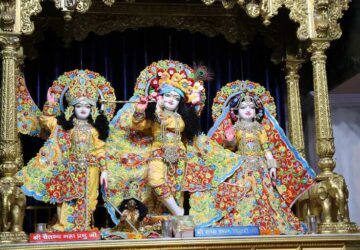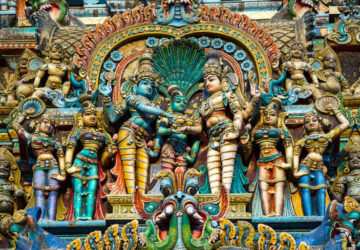
Big Wild Goose Pagoda is a Buddhist pagoda in China located in southern Xi’an of Shaanxi province. It was built with the purpose of storing sutras and figurines of Lord Buddha that were brought to China from all over the world. Big Wild Goose Pagoda is a well-preserved ancient monument considered as a key cultural relic of China. Standing in the Da Ci’en Temple complex the Pagoda attracts thousands of Buddhists and tourists from all over the world.
In his quest for Buddhist symbols the learned scholar Xuanzang undertook a perilous expedition starting from Xian, along the Silk Route, through deserts and finally arrived in India which, in those days, was the cradle of Buddhism. From here he embarked on a long journey lasting 17 years and traversing 100 countries collecting numerous Buddha figures, sutras and relics. The Sanskrit sutras were translated into Chinese and all the artefacts that he had reverently collected during his long sojourn were placed in the Big Wild Goose Pagoda.
The tale of the Legend
The Big Wild Goose Pagoda has been named after a legend. According to ancient stories there were two branches of Buddhists for one of which eating meat was not a taboo. One day they could not find meat to buy. Upon seeing a group of big wild geese flying by, a monk said, ‘Today we have no meat. I hope the merciful Bodhisattva will give us some.’ At that very moment the leading wild goose broke its wings and fell to the ground. All the monks were startled and believed that this was a sign from the Bodhisattva to be more pious. Consequently they stopped eating meat and built a pagoda where the wild goose had fallen. Hence the pagoda came to be called the ‘Big Wild Goose Pagoda’.
The Pagoda forms part of a gigantic and splendid complex which can be divided into three parts: the Big Wild Goose Pagoda, the Da Ci’en Temple and the North Square.
The Big Wild Goose Pagoda: A masterpiece of Buddhist architecture
Xuanzang, who was the first abbot of Da Ci’en Temple, supervised the building of the Big Wild Goose Pagoda. Originally built in 652 during the reign of Emperor Gaozong of the Tang Dynasty this construction eventually collapsed. Five decades later the structure was rebuilt in 704 during the reign of Empress Wu Zetian and its exterior renovated during the Ming Dynasty. A massive earthquake in 1556 severely damaged the pagoda and reduced it to its current height of seven stories. The Big Wild Goose Pagoda was extensively repaired during the Ming Dynasty and renovated again in 1964.
The Pagoda is a masterpiece of Buddhist construction. It was initially built to a height of 197 feet with five stories but later two stories were added and now it stands at 212 feet. It looks like a square cone, simple but grand. Inside the pagoda stairs twist their way upwards allowing visitors a panoramic view of Xian City from the four arch-shaped doors on each storey. On the walls are engraved fine statues of Buddha made by the renowned artist Yan Liben. Steles by noted calligraphers also grace the pagoda.
It is the oldest and highest wooden structure in China and is regarded as the “First Pagoda in the World”. An architectural gem, this man made wonder is built without the use of nails. An impressive and elegant structure it has stood strong against 900 years of wind, storm and earthquakes and has remained intact.
Da Ci’en Temple: A dedication to a noble monk
Da Ci’en Temple is the home of the Big Wild Goose Pagoda. In 648, to commemorate the dead virtuous queen mother Empress Wende and Emperor Gaozong ordered the building of a temple named ‘Ci’en’ (Mercy and Kindness). The status and scale of the temple far exceeded all others. Today, with an area of 38,650 square yards it looks grand and glorious.
Before the temple stands a statue of the laudable hierarch Xuanzang. On entering the temple you will see two buildings – Bell Tower to the east and Drum Tower to the west. Inside the Bell Tower hangs an iron bell weighing 15 tons. It was moulded in 1548 in the Ming Dynasty. Along the central axis are arranged the Hall of Mahavira, Sermon Hall, Big Wild Goose Pagoda and the Hall of Xuanzang Sanzang. In the Hall of Mahavira are carved statues of Buddha and 18 arhats (a Buddhist who has attained Nirvana) including that of Xuanzang. The Hall of Xuanzang Sanzang is to the north of the Big Wild Goose Pagoda. In this big hall are his relics and a bronze statue of a seated Xuanzang. The inner wall is chiselled with murals depicting this hierarch’s story.
North Square: A must see tourist spot
Surrounding Big Wild Goose Pagoda is the square north of the Da Ci’en Temple. Covering about 131,570 square yards plus 23,920 square yards of water area, it is the biggest Tang dynasty culture square with the biggest musical fountain and waterscape and the largest sculpture area. It has the most number of benches, the longest light-belt and the largest acoustic complex.
The entire square is composed of waterscape fountains, a cultural square, gardens and tourist paths. Here you get to see real Chinese culture and traditions. With reliefs on the theme of the prosperous Tang Dynasty, 656-foot-long sculpture groups, 8 groups of sculpted figures, 40 reliefs and 22 styles of musical fountains, it has become a must-see when you visit the Big Wild Goose Pagoda.
The Big Wild Goose Pagoda is indeed a masterpiece of ancient Chinese architecture symbolizing Buddhist culture in all its serene and spiritual splendour. A collection of exquisite and exceptional Buddhist artefacts, it is a much treasured site to visit in our China tour packages irrespective of whether you are a Buddhist or not.





Related Post
10 Best Places To Visit Around The World In April (2023)
Places to Visit in January, February and March (2024)
Bungee Jumping Around The World
Travelling With Your Girl Gang
Tulip Festivals Across The Globe
Offbeat International Honeymoon Destinations
Asian Food - A Culinary Adventure
Singapore Vacation 101
Dubai Shopping Festival – Why You Should not Miss this Extravaganza!
5 Enchanted Waterfalls in Laos to Take Your Breath Away!